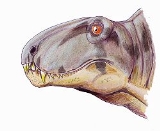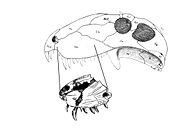
Bathygnathus
Encyclopedia

Pelycosaur
The pelycosaurs are an informal grouping composed of basal or primitive Late Paleozoic synapsid amniotes. Some species were quite large and could grow up to 3 meters or more, although most species were much smaller...
-grade synapsid
Synapsid
Synapsids are a group of animals that includes mammals and everything more closely related to mammals than to other living amniotes. They are easily separated from other amniotes by having an opening low in the skull roof behind each eye, leaving a bony arch beneath each, accounting for their name...
, a non-dinosaur
Dinosaur
Dinosaurs are a diverse group of animals of the clade and superorder Dinosauria. They were the dominant terrestrial vertebrates for over 160 million years, from the late Triassic period until the end of the Cretaceous , when the Cretaceous–Paleogene extinction event led to the extinction of...
ian amniote which lived during the Permian
Permian
The PermianThe term "Permian" was introduced into geology in 1841 by Sir Sir R. I. Murchison, president of the Geological Society of London, who identified typical strata in extensive Russian explorations undertaken with Edouard de Verneuil; Murchison asserted in 1841 that he named his "Permian...
Period (about 270 Ma). The only specimen of Bathygnathus was discovered on Prince Edward Island
Prince Edward Island
Prince Edward Island is a Canadian province consisting of an island of the same name, as well as other islands. The maritime province is the smallest in the nation in both land area and population...
during the course of a well excavation, in Spring Brook in the New London area and its significance recognized by the local naturalist Francis Bain
Francis Bain
Francis Bain was an author, scientist and farmer from North River, Prince Edward Island.In 1865, in his time away from managing his family farm, he began a career as an amateur naturalist, collecting and cataloging the flora, fauna, and seashells of the island...
. It was originally described by Leidy in 1855 as the lower jaw of a dinosaur. The specimen is now known to represent the upper jaw (maxilla) of a sphenacodontid synapsid.

